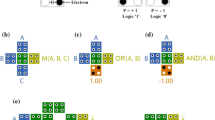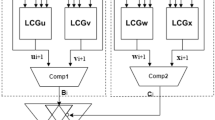Abstract
The design of cryptographic applications needs special care. For instance, physical attacks like side-channel analysis (SCA) are able to recover the secret key, just by observing the activity of the computation, even for mathematically robust algorithms like AES. SCA considers the “leakage” of a well chosen intermediate variable correlated with the secret. Field programmable gate-arrays (FPGA) are often used for hardware implementations for low to medium volume productions or when flexibility is needed. They offer many possibilities for the computation, like small look-up tables (LUT) and embedded block memories (BRAM). Certain countermeasures can be deployed, like dual-rail logic or masking, to resist SCA on FPGA. However to design an effective countermeasure, it is of prime importance for a designer to know the main leakage sources of the device. In this paper, we analyze the leakage source of a Xilinx Virtex V FPGA by studying three different AES architectures. The analysis is based on real measurements by using specific leakage models of the sensitive variable, adapted to each architecture. Our results demonstrate that, BRAM which were considered to leak less traditionally, are found to be equally vulnerable if we change the attack target from address register to output latch. We also show that if the leakage model is known, simple countermeasures with only 16 % overhead can be deployed to overcome the leakage.


















Similar content being viewed by others
Notes
There are actually several kinds of “ghost peaks”. In this footnote, we give some examples from the SCA literature in order to disambiguate the different origins of wrong key guesses phenomenon. One example is when a high spurious correlation is obtained at an irrelevant position of the trace, which happens when there is a lot of noise and few traces traces available to estimate the CPA. This is illustrated for instance in Fig. 3 of [14] (it is labelled “noisy peak”). Another kind of ghost peak can appear because unrelated activity occurs simultaneously with that being exploited. This has been exemplified in [10, Section 5.1], on the example of a hardware DES. If the attacker applies a mono-bit difference-of-means, then the attack can fail, because the three ignored bits (assumed erroneously to be independent from the one under analysis) leak information that overcomes the target bit, and fools the attacker into finding an incorrect key. In this section, we account for another type of ghost peaks, that happen later in time than the primary leakage, for a leakage model that involves the sensitive variable used “transformed”.
References
Grøstl–a SHA-3 candidate. http://www.groestl.info/Groestl.pdf. Accessed 17 Aug 2012
Altera. Stratix-II Device Handbook, vol. 1. http://www.altera.com/literature/hb/stx2/stratix2handbook.pdf
Batina, L., Gierlichs, B., Prouff, E., Rivain, M., Standaert, F.-X., Veyrat-Charvillon, N.: Mutual information analysis: a comprehensive study. J. Cryptol. 24(2), 269–291 (2011)
Benoît, O., Peyrin, T.: Side-channel analysis of six SHA-3 candidates. In: CHES. Lecture Notes in Computer Science, vol. 6225, pp. 140–157. Springer, Santa Barbara, CA, USA, 17–20 Aug 2010
Bhasin, S., Guilley, S., Souissi, Y., Graba, T., Danger, J.-L.: Efficient dual-rail implementations in FPGA using Block RAMs. In: ReConFig, pp. 261–267. IEEE Computer Society, 30 Nov to 2 Dec 2011. Cancún, Quintana Roo, México. doi:10.1109/ReConFig.2011.32 (2011)
Bhasin, S., Selmane, N., Guilley, S., Danger, J.-L.: Security evaluation of different AES implementations against practical setup time violation attacks in FPGAs. In: HOST (Hardware Oriented Security and Trust), pp. 15–21, 27 July 2009. IEEE Computer Society. doi:10.1109/HST.2009.5225057; In conjunction with DAC-2009, Moscone Center, San Francisco, CA, USA
Biham, E., Shamir, A.: Differential fault analysis of secret key cryptosystems. In: CRYPTO 97, LNCS, vol. 1294, pp. 1513–1521. Springer, Berlin (1997)
Bogdanov, A., Knudsen, L.R., Leander, G., Paar, L., Poschmann, A., Robshaw, M.J.B., Seurin, Y., Vikkelsoe, C.: PRESENT: an ultra-lightweight Block Cipher. In: CHES. Lecture Notes in Computer Science, vol. 4727, pp. 450–466, 10–13 September 2007. Springer, Vienna (2007)
Brier, É., Clavier, C., Olivier, F.: Correlation power analysis with a leakage model. In: CHES. LNCS, vol. 3156, pp. 16–29, 11–13 Aug 2004. Springer, Cambridge (2004)
Canovas, C., Clediere, J.: What do S-boxes say in differential side channel attacks? Cryptology ePrint Archive, Report 2005/311. http://eprint.iacr.org/ (2005)
Chari, S., Jutla, C.S., Rao, J.R., Rohatgi, P.: Towards sound approaches to counteract power-analysis attacks. In: CRYPTO. LNCS, vol. 1666, 15–19 Aug 1999. Springer, Santa Barbara. ISBN:3-540-66347-9 (1999)
Doget, J., Prouff, E., Rivain, M., Standaert, F.-X.: Univariate side channel attacks and leakage modeling. J. Cryptographic Eng. 1(2), 123–144 (2011)
Drimer, S., Güneysu, T., Paar, C.: DSPs, BRAMs and a Pinch of logic: new recipes for the AES on FPGAs. In: IEEE Symposium on Field-Programmable Custom Computing Machines (FCCM), pp. 99–108. IEEE, Stanford. 14–15 Apr 2008
Guilley, S., Sauvage, L., Danger, J.-L., Selmane, N., Pacalet, R.: Silicon-level solutions to counteract passive and active attacks. In: Breveglieri, L., Gueron, S., Koren, I., Naccache, D., Seifert, J.-P. (eds.) FDTC, pp. 3–17. IEEE Computer Society (2008)
Heuser, A., Schindler, W., Stöttinger, M.: Revealing side-channel issues of complex circuits by enhanced leakage models. In: Rosenstiel, W., Thiele, L. (eds.) DATE, pp. 1179–1184. IEEE (2012)
Kasper, M., Schindler, W., Stöttinger, M.: A stochastic method for security evaluation of cryptographic FPGA implementations. In: Bian, J., Zhou, Q., Athanas, P., Ha, Y., Zhao, K. (eds.) FPT, pp. 146–153. IEEE (2010)
Maghrebi, H., Carlet, C., Guilley, S., Danger, J.-L.: Optimal first-order masking with linear and non-linear bijections. In: Mitrokotsa, A., Vaudenay, S. (eds.) AFRICACRYPT. Lecture Notes in Computer Science, vol. 7374, pp. 360–377. Springer, Berlin (2012)
Maghrebi, H., Prouff, E., Guilley, S., Danger, J.-L.: A first-order leak-free masking countermeasure. In: CT-RSA. LNCS, vol. 7178, pp. 156–170, 27 February to 2 March 2012. Springer, San Francisco (2012). doi:10.1007/978-3-642-27954-6_10
Moradi, A., Kasper, M., Paar, C.: On the portability of side-channel attacks—an analysis of the Xilinx Virtex 4 and Virtex 5 bitstream encryption mechanism. Cryptology ePrint Archive, Report 2011/391. http://eprint.iacr.org/2011/391/ (2011)
Nassar, M., Souissi, Y., Guilley, S., Danger, J.-L.: RSM: a small and fast countermeasure for AES, secure against first- and second-order zero-offset SCAs. In: DATE, pp. 1173–1178, Dresden, Germany, 12–16 March 2012. (TRACK A: “Application Design”, TOPIC A5: “Secure Systems”) http://hal.archives-ouvertes.fr/hal-00666337/en (2012)
NIST/ITL/CSD.: Data Encryption Standard. FIPS PUB 46–3, Oct 1999. http://csrc.nist.gov/publications/fips/fips46-3/fips46-3.pdf
NIST/ITL/CSD.: Advanced Encryption Standard (AES). FIPS PUB 197, Nov 2001. http://csrc.nist.gov/publications/fips/fips197/fips-197.pdf
Prouff, E., Rivain, M.: Theoretical and practical aspects of mutual information based side channel analysis. In: Springer (ed.) ACNS, LNCS, vol. 5536, pp. 499–518, Paris-Rocquencourt, France, 2–5 June 2009
Réal, D., Dubois, V., Guilloux, A.-M., Valette, F., Drissi, M.: SCARE of an unknown hardware Feistel implementation. In: CARDIS. LNCS, vol. 5189, pp. 218–227. Springer, London (2008)
Schindler, W., Lemke, K., Paar, C.: A stochastic model for differential side channel cryptanalysis. In: LNCS (ed.) CHES. LNCS, vol. 3659, pp. 30–46. Springer, Edinburgh, Sept 2005
Shah, S., Velegalati, R., Kaps, J.-P., Hwang. D.: Investigation of DPA resistance of block RAMs in cryptographic implementations on FPGAs. In: Prasanna, V.K., Becker, J., Cumplido, R. (eds.) ReConFig, pp. 274–279. IEEE Computer Society (2010)
TELECOM ParisTech SEN research group. DPA Contest, 2nd edn. http://www.DPAcontest.org/v2/ (2009–2010)
Tiri, K., Verbauwhede, I.: A logic level design methodology for a secure DPA resistant ASIC or FPGA implementation. In: DATE’04, pp. 246–251. IEEE Computer Society, Paris. France. doi:10.1109/DATE.2004.1268856 (February 2004)
Xilinx.: Spartan-6 FPGA Block RAM Resources User Guide—UG383 (v1.5). http://www.xilinx.com/support/documentation/user_guides/ug383.pdf
Acknowledgments
This research is partly supported by Strategic International Cooperative Program (Joint Research Type), Japan Science and Technology Agency (JST), and the French Agence Nationale pour la Recherche (ANR), via grant for project SPACES (Security evaluation of Physically Attacked Cryptoprocessors in Embedded Systems). The authors wish to thank Julien Francq and Antoine Wurker (EADS/Cassidian, Cyber Security Solutions Center) for insightful discussions about power attacks on AES and Grøstl [1].
Author information
Authors and Affiliations
Corresponding author
Rights and permissions
About this article
Cite this article
Bhasin, S., Guilley, S., Heuser, A. et al. From cryptography to hardware: analyzing and protecting embedded Xilinx BRAM for cryptographic applications. J Cryptogr Eng 3, 213–225 (2013). https://doi.org/10.1007/s13389-013-0048-4
Received:
Accepted:
Published:
Issue Date:
DOI: https://doi.org/10.1007/s13389-013-0048-4




